DFA to Regular Expression | Theory of Computation - Computer Science Engineering (CSE) PDF Download
Introduction
The two popular methods for converting a DFA to its regular expression are: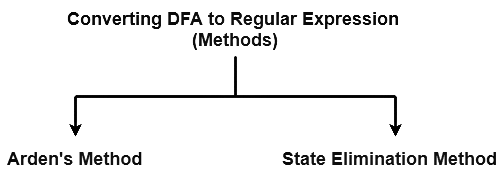
- Arden’s Method
- State Elimination Method
State Elimination Method
This method involves the following steps in finding the regular expression for any given DFA
Step 1:
Thumb Rule
The initial state of the DFA must not have any incoming edge.
If there exists any incoming edge to the initial state, then create a new initial state having no incoming edge to it.
Example:
Step 2:
Thumb Rule
There must exist only one final state in the DFA.
If there exists multiple final states in the DFA, then convert all the final states into non-final states and create a new single final state.
Example:

Step 3:
Thumb Rule
The final state of the DFA must not have any outgoing edge.
Example:
Step 4:
- Eliminate all the intermediate states one by one.
- These states may be eliminated in any order.
In the end,
- Only an initial state going to the final state will be left.
- The cost of this transition is the required regular expression.
Note: The state elimination method can be applied to any finite automata.
(NFA, ∈-NFA, DFA etc)
Practice Problems Based on Converting DFA to Regular Expression
Problem 1: Find regular expression for the following DFA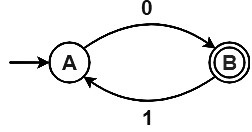
Solution:
Step 1:
- Initial state A has an incoming edge.
- So, we create a new initial state qi.
The resulting DFA is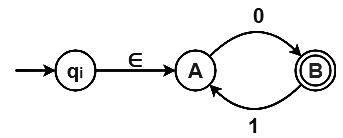
Step 2:
- Final state B has an outgoing edge.
- So, we create a new final state qf.
The resulting DFA is
Step 3: Now, we start eliminating the intermediate states.
First, let us eliminate state A.
- There is a path going from state qi to state B via state A.
- So, after eliminating state A, we put a direct path from state qi to state B having cost ∈.0 = 0
- There is a loop on state B using state A.
- So, after eliminating state A, we put a direct loop on state B having cost 1.0 = 10.
Eliminating state A, we get

Step 4: Now, let us eliminate state B.
- There is a path going from state qi to state qf via state B.
- So, after eliminating state B, we put a direct path from state qi to state qf having cost 0.(10)*.∈ = 0(10)*
Eliminating state B, we get

From here,
Regular Expression = 0(10)*
Note: In the above question,
- If we first eliminate state B and then state A, then regular expression would be = (01)*0.
- This is also the same and correct.
Problem 2: Find regular expression for the following DFA

Solution:
Step 1:
- There exist multiple final states.
- So, we convert them into a single final state.
The resulting DFA is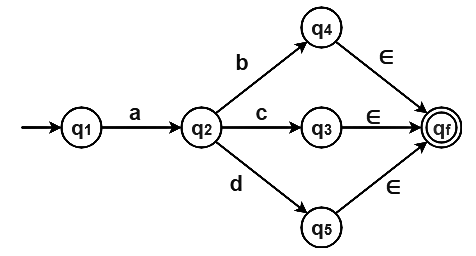
Step 2: Now, we start eliminating the intermediate states.
First, let us eliminate state q4.
- There is a path going from state q2 to state qf via state q4.
- So, after eliminating state q4 , we put a direct path from state q2 to state qf having cost b.∈ = b.
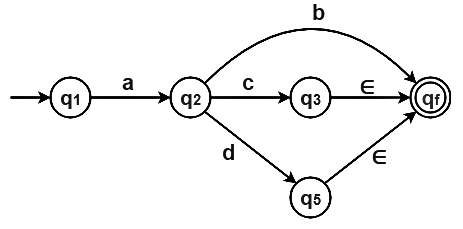
Step 3: Now, let us eliminate state q3.
- There is a path going from state q2 to state qf via state q3.
- So, after eliminating state q3 , we put a direct path from state q2 to state qf having cost c.∈ = c.

Step 4: Now, let us eliminate state q5.
- There is a path going from state q2 to state qf via state q5.
- So, after eliminating state q5 , we put a direct path from state q2 to state qf having cost d.∈ = d.
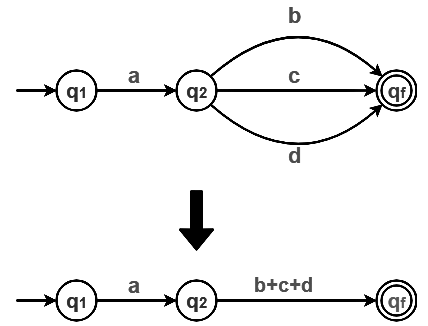
Step 5: Now, let us eliminate state q2.
- There is a path going from state q1 to state qf via state q2.
- So, after eliminating state q2 , we put a direct path from state q1 to state qf having cost a.(b+c+d).

From here,
Regular Expression = a(b+c+d)
|
20 videos|95 docs|44 tests
|




















